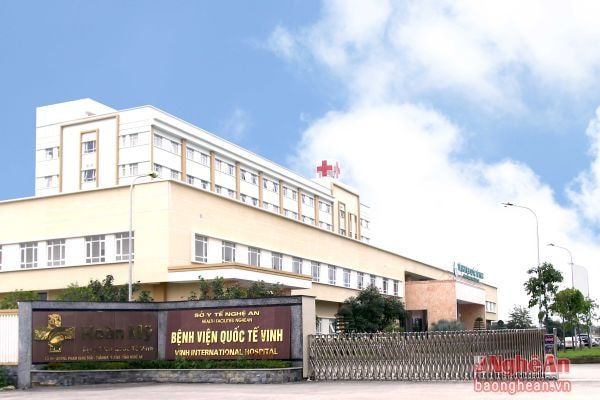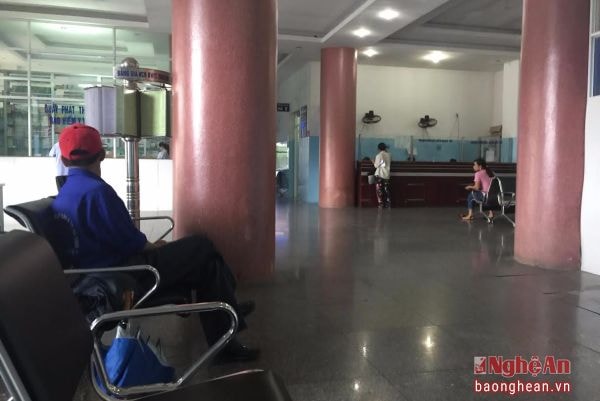Health Insurance Deficit: Hospitals with huge investments, request to be 'demoted'
(Baonghean) - On November 16, 2015, the Ministry of Health issued Circular 40 on implementing the "cross-line" policy in medical examination and treatment (effective January 1, 2016). Whether it was intentional or not, at the end of September 2015, all class II private hospitals (provincial level) in Nghe An province simultaneously requested to be downgraded to class III (district level).
Lesson 1:>>> With a health insurance card, going to the hospital is as easy as... going to the market
Lesson 3: >>>Health Insurance Fund Deficit: 'Broken' then 'Firefighting'
“5 star quality, 3 star price”
 |
| Vinh International Hospital is one of the private hospitals from the provincial level that requested to be downgraded to the district level. |
Implementing Resolution 26-NQ/TW, dated July 30, 2013 of the Politburo on striving to build Nghe An into a Medical Center of the North Central region, Nghe An has focused on investing in the health sector, promoting socialization to improve the quality of medical examination and treatment, and serving patients. Many private hospitals have been established with the "mission" of becoming leading medical examination and treatment hospitals in the country, a trusted address for the people. Currently, Nghe An is the province with the third largest number of non-public hospitals in the country, after Hanoi and Ho Chi Minh City.
On January 21, 2014, the People's Committee of Nghe An province issued Official Dispatch No. 403/UBND-TM agreeing to allow private hospitals in the province to temporarily enjoy the payment level for health insurance examination and treatment equivalent to that of public hospitals of level II (provincial level hospitals). However, just over 1 month before the issuance of Circular 40 of the Ministry of Health on "inter-line" in medical examination and treatment, private hospitals in Nghe An province simultaneously submitted a request to be demoted to level III (district level hospitals) with the content "Based on the conditions of facilities, medical equipment, and existing human resources; to fully promote the capacity and technical expertise of the hospital in medical examination and treatment to contribute to better serving the staff and people in the locality and in the region".
| Article 8, Chapter III, Circular 40 clearly states: “Health insurance participants have the right to register for initial health insurance examination and treatment at one of the medical examination and treatment facilities specified in Article 3 and Article 4 of this Circular, regardless of administrative boundaries, in accordance with the workplace, place of residence and the capacity of the medical examination and treatment facility”. That means, at the initial health insurance examination and treatment facility at the commune level or the initial health insurance examination and treatment facility at the district level and equivalent, people will have the right to register for initial health insurance examination and treatment. Conversely, if the hospital is ranked level III (district level), it will be able to provide medical examination and treatment according to the provisions of this Circular. |
In October 2015, the Department of Medical Examination and Treatment Management (Ministry of Health) issued an Official Letter supporting the policy of recognizing 10 private hospitals in Nghe An as medical examination and treatment facilities equivalent to district level (grade III) to participate in medical examination and treatment for local people and medical examination and treatment under health insurance. The Official Letter also requested the hospitals to contact the Department of Health, the Social Insurance Agency of Nghe An province for guidance in accordance with the provisions of the Law on Medical Examination and Treatment, the Law on Health Insurance and related guiding documents.
On December 16, 2015, Nghe An Department of Health issued Official Letter No. 3181/SYT-NYV to the Provincial Social Insurance asking for opinions on the temporary ranking of private hospitals. Afterwards, Nghe An Social Insurance issued Official Letter No. 3913/BHXH-GĐBHXH in response: Most of the non-public hospitals in the area have relatively modern and synchronous equipment, a team of highly qualified staff, and have performed many advanced techniques.
Therefore, based on Official Dispatch No. 6969/BYT-KHTC dated October 30, 2013 of the Ministry of Health on instructions for payment of health insurance examination and treatment costs at private medical examination and treatment facilities, Nghe An Provincial Social Insurance proposes to continue to temporarily classify non-public hospitals in the area as equivalent to Grade II, provincial level as the opinion of the Chairman of the Provincial People's Committee in Official Dispatch No. 403/UBND-TM dated January 21, 2014.
However, on December 23, 2015, Nghe An Department of Health still submitted a proposal to the Provincial People's Committee to temporarily regulate private general hospitals in Nghe An province equivalent to grade III hospitals at district level to serve as facilities for initial medical examination and treatment, referrals and payment of health insurance examination and treatment costs; specifically 10 facilities: Vinh International General Hospital, Minh Hong General Hospital, 115 General Hospital, Cua Dong General Hospital, Thai An General Hospital, Dong Au General Hospital, Phu Dien General Hospital; Thanh An Saigon General Hospital, Saigon Eye Hospital, Thai Thuong Hoang Dental Hospital.
Questioning the fact that private hospitals advertise that they have modern facilities, equipment, a team of good doctors, and even invite leading experts from the level equivalent to a class II hospital to "drop" to class III, Mr. Hoang Van Hao - Deputy Director of Nghe An Department of Health said: In fact, there is currently no set of criteria to evaluate and classify non-public hospitals. The "ranking" equivalent to district and provincial levels is to follow the correct procedure when health insurance pays. "Downgrading" or "upgrading" is not as important as serving the needs of medical examination and treatment and the interests of the people. "It's like a 5-star hotel with 3-star prices," said the Deputy Director of the Department of Health.
Putting aside the validity of the above-mentioned "downgrade", the reality is that after Circular 40 on implementing the "through-line" policy in medical examination and treatment took effect, there appeared a "trend" of going to private hospitals for medical examination and treatment because according to many people, the quality of medical examination and treatment here is better, they are served quickly, and they can use many services and modern machines without spending much because they are covered by health insurance.
Open route, "downgraded": A journey full of problems
Thanks to the "shortcut" of Circular 40, private hospitals in Nghe An have become "initial health insurance examination and treatment facilities at district level and equivalent". The number of initial medical examinations at these hospitals has therefore also increased exponentially. According to preliminary statistics, in the first 6 months of 2016, the number of outpatient examinations and treatment at Cua Dong General Hospital was over 53,596, Nghe An 115 Hospital 30,031; Vinh International Hospital 16,825; Quang Khoi Private General Clinic 18,569; Minh Hong General Hospital 12,007, Dong Au General Hospital 12,861, Thanh An Saigon General Hospital 11,198...
 |
| The medical examination and treatment area of Thanh An Saigon General Hospital is deserted, but according to the report data for the first 6 months of 2016, there were still more than 11,000 patients receiving initial medical examination and treatment. |
On the one hand, the fact that private hospitals are allowed to provide medical examination and treatment through the network helps reduce the pressure on public hospitals at the same level when Circular 40 takes effect. The scenario of "breaking out" of medical examination and treatment has been anticipated by management agencies and is completely at risk of happening because the medical facilities of the public system have a low growth rate, making it difficult to meet the sudden increase in the demand for medical examination and treatment. In fact, the situation of overloaded medical examination tables at some public facilities has been recorded. When private hospitals are allowed to provide medical examination and treatment through the network, it will attract a part of patients, avoiding the above "breaking out" scenario. Indeed, the number of initial medical examinations after Circular 40 took effect has increased dramatically in the non-public sector.
However, the “equating” of private medical examination and treatment facilities with public district-level facilities has a clear difference in terms of facilities, equipment and human resources, leading to many shortcomings. Is the use of “5-star quality, 3-star price” medical examination and treatment services really beneficial to patients?
In fact, the health insurance payment levels for medical examination and treatment facilities at different levels are not the same. Naturally, upper-level hospitals will enjoy higher payment levels than lower-level hospitals (facilities, more diverse services and larger scope of operations). Thus, if patients go to medical examination and treatment facilities that apply payment levels for lower-level facilities, but use modern, high-tech medical examination and treatment services, they will not enjoy the same payment levels as those at upper-level facilities. This is the reality that is happening in some private hospitals after being approved for "downgrading".
On December 30, 2015, Vietnam Social Security issued Official Dispatch No. 5388/BHXH-CSYT on instructions to resolve some difficulties in implementing the health insurance policy, including the following provision: "For private hospitals, in 2015, it was agreed to pay at the same price as a class II hospital. In 2016, it will continue to be implemented as in 2015, identified as a provincial-level medical examination and treatment facility and will not perform cross-line medical examination and treatment." If provincial-level medical examination and treatment facilities are allowed to perform cross-line medical examination and treatment, they must "wait" until January 1, 2021 according to the Law amending and supplementing a number of articles of the Health Insurance Law passed on June 13, 2014.
(To be continued)
PV Group

